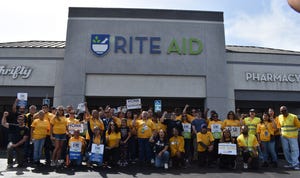Where the boys are
January 1, 2018
Thanks to an influx of male shoppers and value- based products, the men’s grooming category continues to grow. By Deena M. Amato-McCoy For years, women had the spending power across most categories in the supermarket, including health and beauty care, where they chose the ideal personal care and toiletry items for themselves and the male members of their households. A majority of men were satisfied, or just plain indifferent, when the toiletries magically appeared in their showers and medicine cabinets. Today, a significant number of men have taken on more domestic responsibilities—a move that has a majority of men identifying themselves as the primary household shopper. A study conducted by Sunnyvale, Calif.-based Yahoo! reported that 51% of men are taking on this role. More specifically, 35% of supermarket and mass merchandiser shoppers are male, according to officials at New York-based shopper marketing network Saatchi & Saatchi X. The recession is also driving men’s interest in personal care, not only as a sign of being healthy, but also “to gain an edge in a competitive marketplace,” says Jeff Carducci, national sales director for Simi Valley, Calif.-based derma e Natural Bodycare. “Consumers feel more pressure [regarding their appearance] in the corporate world.” Men are showing more interest in male-specific toiletries such as body wash, hair care and deodorant—categories that are growing faster than shaving hardware, according to Rob Candelino, marketing director for AXE, a brand of Unilever, based in Englewood Cliffs, N.J. Designed for men More importantly, industry observers say they are seeking merchandise that addresses their personal care needs better than unisex or female products—a trend that is changing product offerings within the men’s personal care category. “We are not out to create new grooming habits, but instead to create personal care products designed specifically for him that fit into the habits he already has,” Candelino explains. To attract these new shoppers, supermarkets needed to give their traditional men’s grooming category a makeover and rethink their target audiences, insiders say. Retailers are no longer catering to older, mature shoppers simply looking for basic shaving creams, razors and aftershaves. “Today, there is a totally new user,” explains Jerry Foy, vice president of contract sales and marketing for Grand Rapids, Mich.-based Surefil. “Retailers want to grow the category and they are focusing on a consumer that they can target for the next 30 or 40 years. These shoppers are younger, more hip shoppers.” Observers credit the introduction of AXE for driving this change. The brand, which was created specifically for the 18- to 24-year-old male demographic, made its mark more than five years ago in the supermarket and drug channels with its low-cost deodorant line. The brand’s popularity helped it expand to hair products, body spray and shower gels. “While AXE is credited with reshaping the deodorant category, the brand is currently experiencing tremendous growth within the personal wash and hair care categories,” Candelino says. AXE’s first shower gel hit the marketplace in 2005, yet “it remains the top men’s shower gel brand on the market,” he says. “Building off of the brand’s popularity, the AXE shower line continues to innovate to further solidify this position.” The shower gel recently underwent a redesign, including a more modern-looking bottle with a masculine grip and click-to-open top that better controls the amount of gel being dispensed. Three new scents—Cool Metal, Excite and Thai Massage—are expected to launch soon, according to company officials. Later this year, the brand will expand its full line of hair care products (shampoos, conditioners and styling products) with the introduction of its AXE Crew Cut Buzzed Look Cream SPF 15, a product designed to protect men’s scalps from UVA/UVB rays while keeping hair soft. Price conscious AXE continues to prove that a combination of innovation, packaging and, more importantly, low price-points are helping to spur the growth of this category, according to observers. “In fact, the low cost point of AXE has encouraged other brands to come out with new products at these lower prices, giving shoppers more choices that mimic high-level products previously only available in a salon or department store,” says Jessica Gaddis, Surefil’s marketing coordinator. Both Suave and Dove, two Unilever brands that are strong in the women’s hair care and body care categories, followed AXE’s lead and also launched value-based male grooming products in 2010. After 12 months on the market, sales across the Suave Men line grew 23% compared to a year ago and the Dove Men Care line gained 2.9% market share in the personal wash category, according to company officials. It is not just brands that are focusing on value, observers note. Supermarkets are also looking to attract cost-conscious consumers with private label products. “We are a value-based manufacturer, so we can show our retail partners incremental value as package sizes increase,” says Foy. “Bigger bottles provide a bigger value to shoppers, so we try to target 32-ounce products versus 18-ounce or 15-ounce bottles.” For other shoppers, benefits outweigh cost savings. Derma e is also providing more facial care choices for male shoppers. The supplier’s Pycnogenol skincare line is popular with men looking for a product that cleanses and moisturizes the skin. These fragrance-free formulas deliver antioxidants and nourishing botanicals to help support collagen and elastin health and diminish the appearance of fine lines and wrinkles, according to company officials. “With a primary focus on facial care, we continue to innovate in this category and lead,” says Carducci. “We continue to develop innovative formulas and offer a broad range of price points that are attractive to different consumers and retailers.” For example, the company’s vitamin A platform retails between $10 and $19. Attracting guys While the women’s personal care category is a very mature segment, the men’s care category has plenty of room to grow. Observers note that most stores still devote less than 12 feet of shelf space to the category. “As suppliers and retailers continue to innovate however, there is a great opportunity to bring new consumers into the category and help it expand,” says Carducci. More men may be browsing store aisles, but grocers still have trouble reaching them. A constant influx of new products in a finite amount of space makes it very easy for specific items to get lost in the clutter. Another issue is that men’s “commando” shopping habits make it crucial for retailers to have the right products available during their visits. “For men, commando shopping is very much about getting in, grabbing what they need and leaving,” explains AXE’s Candelino. The key to grabbing the tunnel vision-impaired male shopper is to listen to their feedback, and understand their attitudes and behaviors as they relate to the men’s category. By knowing their preferences, and navigation across the category and the store, supermarkets are in a better position to market men’s care. Getting men to linger Unilever for example, simplifies the shopping experience and disrupts men’s navigation by grabbing their attention in unexpected places. Thanks to channel blurring, men do have “linger points” outside of personal care, such as general merchandise departments that market electronics, music or sporting goods and accessories. Meanwhile, Surefil helps grocers analyze available space, and brainstorm on everything from product and fragrance development to package design. Surefil also helps chains with marketing concepts and displays. “We offer display pallets, four-sided shoppable displays, as well as perforated cases that allow retailers to simply pull the tops off, rather than having to cut it and potentially damage merchandise,” Foy says. Going forward, insiders agree that education will be the key to building sales among the young, but growing category. “Shoppers new to the category clearly need to learn the difference between these products and those targeted to women,” says derma e’s Carducci. “Retailers that can enlighten shoppers about merchandise that caters to benefits of men’s skincare and hair care products will be successful in drawing more shoppers to the category.”
About the Author
You May Also Like




